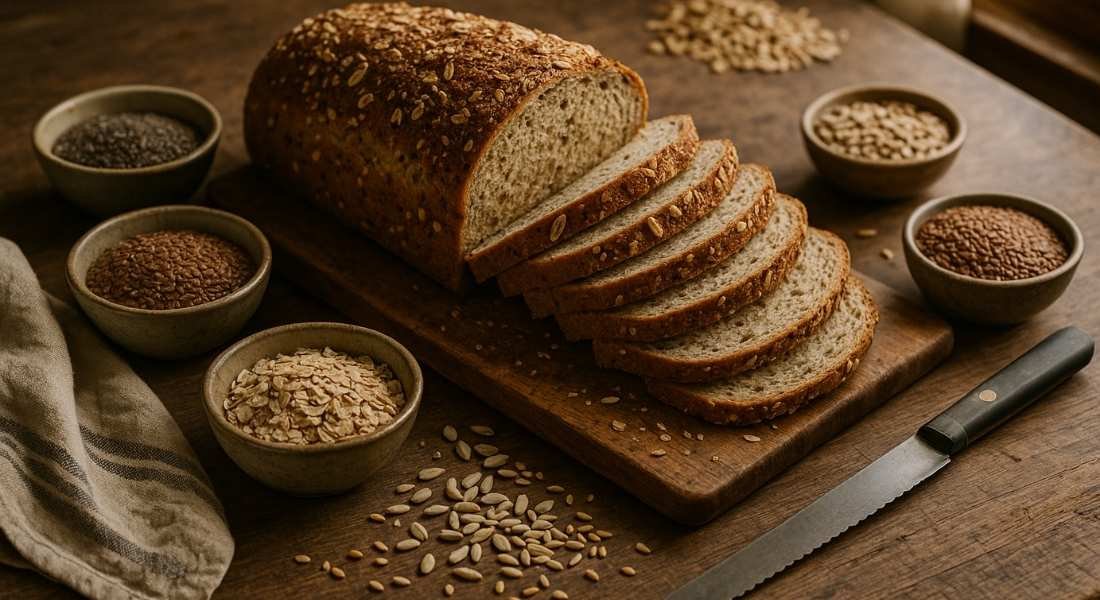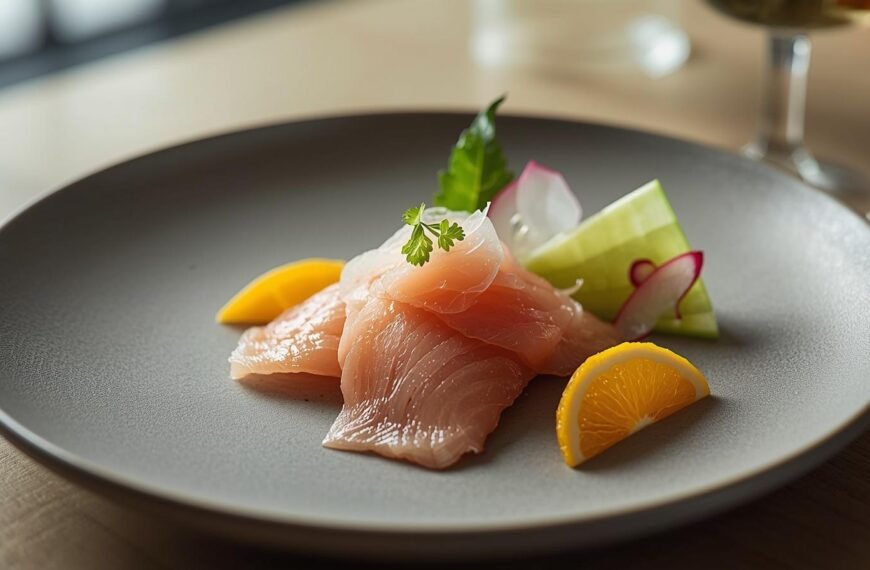If you have ever stood in the bread aisle wondering which loaf is the healthiest bread, you are not alone.
From whole grain and sourdough to flaxseed and gluten free options, choosing a nutritious, tasty and satisfying bread can feel overwhelming.
Let’s break down what truly makes bread healthy and how you can make the best choice for your diet and lifestyle.
What Makes Bread Healthy? A Simple Breakdown
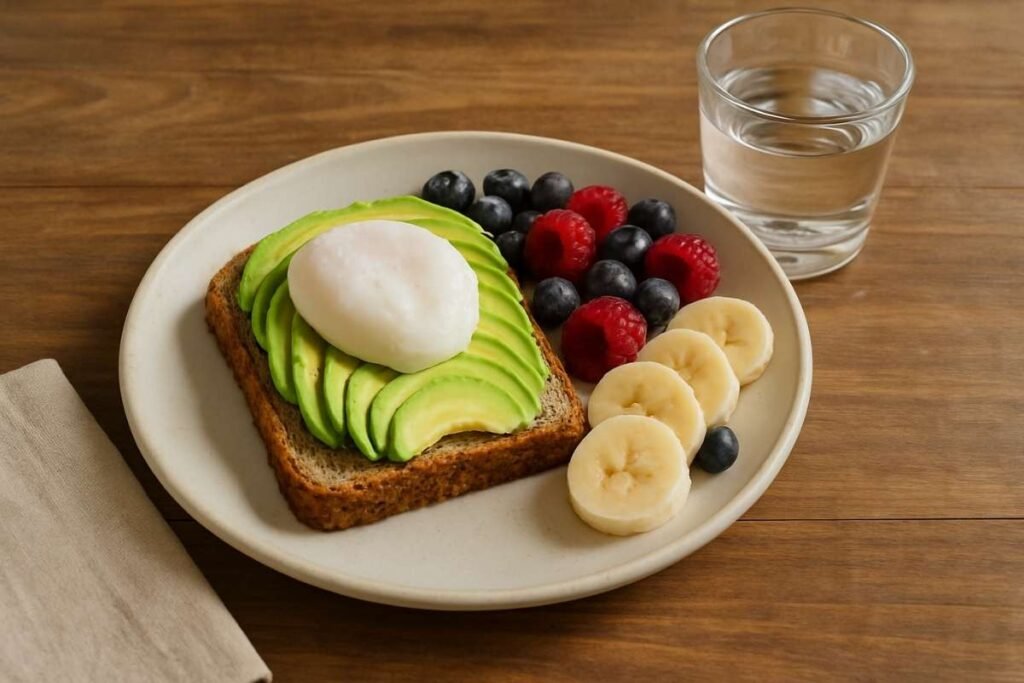
The healthiest bread is more than just a label or a marketing claim. At its core, healthy bread is made with whole foods, contains minimal additives and supports your nutritional needs.
Bread can be a great source of dietary fiber, complex carbohydrates, plant based protein and essential nutrients when made right. Whole grain bread, for example, contains all parts of the grain like the bran, germ and endosperm which makes it it rich in vitamins, minerals, antioxidants and fiber content.
Compared to refined white bread, which strips away most nutrients, whole wheat and sprouted breads provide more health benefits and better support digestive health.
Ezekiel bread, sourdough bread, oat bread, rye bread and flaxseed bread are popular options praised for their nutritional value, low glycemic index and high fiber content.
Why the Healthiest Bread Matters
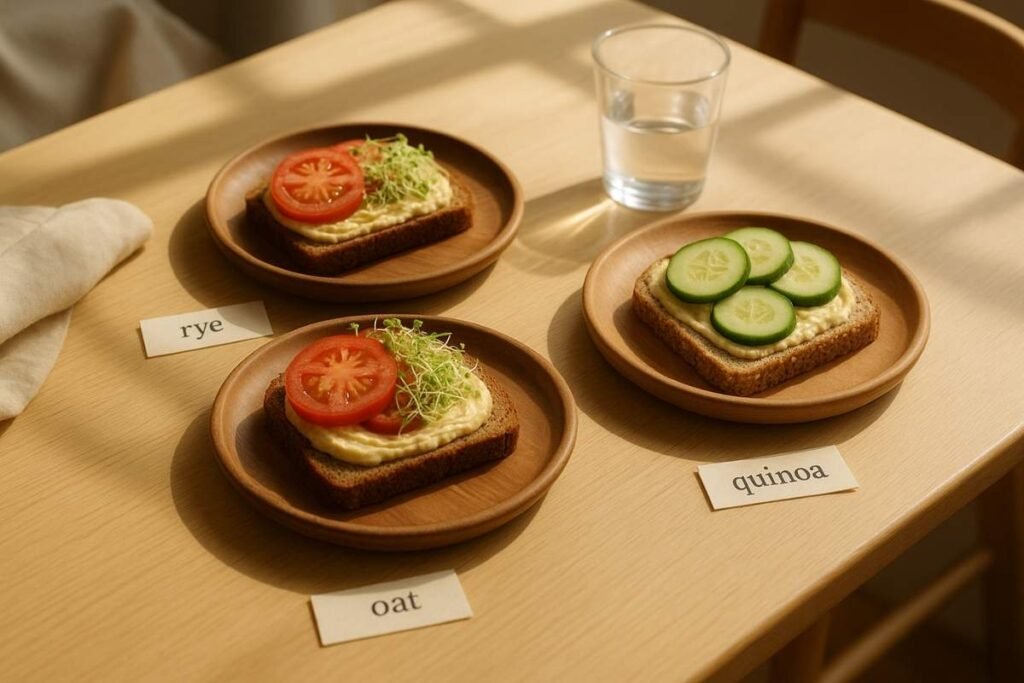
Healthy bread is not just a trend in fact it is a smart lifestyle choice. Incorporating nutrient dense breads into your meals can improve blood sugar control, support gut microbiome diversity and even aid in weight management.
For many, it also means avoiding unnecessary additives, preservatives or sugars commonly found in commercial bread. Choosing the right bread can:
- Improve digestive health through dietary fiber
- Promote heart health with healthy fats and antioxidants
- Offer sustained energy via complex carbohydrates
- Fit into dietary restrictions like vegan, keto or gluten free diets
- Enhance portion control and meal planning with satisfying textures and flavors
When paired with mindful eating habits, choosing the healthiest bread can support a balanced, whole foods based diet that aligns with nutrition education and overall wellness.
The Best Breads for Better Health
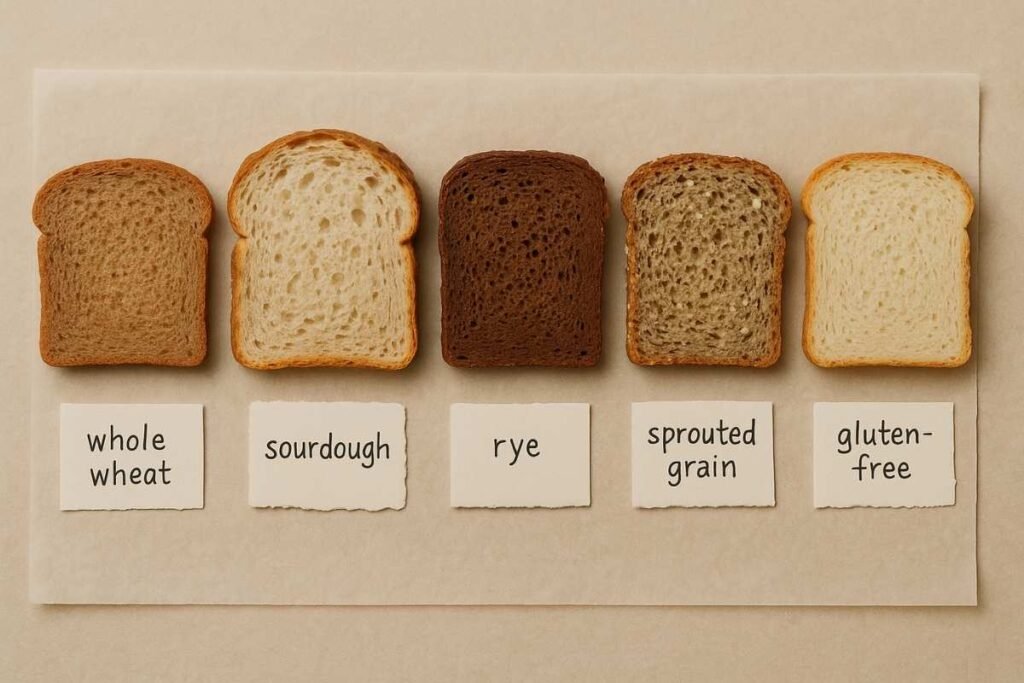
Let’s dive into the most recommended types of bread and what makes each one stand out.
Whole Grain Bread
Whole grain bread remains a top choice among health experts. It retains all three parts of the grain and offers a rich source of fiber, B vitamins and minerals like magnesium and iron.
This type of bread supports heart health, digestive health and can help with cholesterol management. Look for labels that list 100% whole grain as the first ingredient.
Sourdough Bread
Is sourdough the healthiest bread? It is certainly a contender. Thanks to its natural fermentation process, sourdough is easier to digest and has a lower glycemic index than conventional white bread.
This makes it a smart option for blood sugar control. Authentic sourdough is made from just flour, water, salt and a live starter, avoid commercial versions filled with additives.
Sprouted Bread (Ezekiel Bread)
Sprouted bread, like Ezekiel bread, is made from sprouted whole grains and legumes. This method boosts bioavailability of nutrients and makes it easier for your body to absorb vitamins and minerals.
It is also higher in protein and fiber than many conventional breads, making it excellent for a plant based diet or anyone seeking nutrient dense foods.
Flaxseed and Chia Bread
Bread that includes flaxseed or chia seeds packs a punch of omega 3 fatty acids, plant based protein, and fiber. These seeds help reduce inflammation and support heart and digestive health. Always check the ingredient list to ensure they are not just sprinkled on top but actually baked into the dough.
Rye Bread
Rye bread, particularly dark rye, is made with whole rye grains and has a dense texture. It contains high levels of dietary fiber and has been linked to improved satiety and blood sugar balance. It also contains prebiotics that support gut microbiome health.
Oat Bread
Oat bread includes whole oats or oat flour and is often combined with whole wheat flour. Oats are known for lowering cholesterol and supporting heart health. Look for versions with oats listed high on the ingredient list, and beware of sweetened or refined flour versions.
Multigrain Bread
Not all multigrain bread is healthy. The term simply means the bread contains more than one type of grain. Always ensure those grains are whole grains.
Multigrain bread can offer a variety of textures, nutrients and flavors, especially when it includes ancient grains like quinoa, amaranth or millet.
Gluten Free Bread
Gluten free does not automatically mean healthy. Many gluten free breads are made with refined starches and lack fiber. However, gluten free breads made from almond flour, coconut flour or ancient grains like quinoa are healthier alternatives for those with celiac disease or gluten sensitivity.
Low Carb and Keto Bread
For those on low carb or keto diets, look for breads made with almond flour, coconut flour, flaxseed or psyllium husk. These ingredients lower the carb content while increasing fiber and healthy fats. Always check the label for “no sugar added” and minimal ingredients.
Low Calorie Bread
Some brands market low calorie bread as a weight loss tool. While fewer calories per slice can help with portion control, be cautious about additives and preservatives. The healthiest bread for weight loss still comes down to fiber, protein and how full it keeps you.
How to Choose the Healthiest Bread
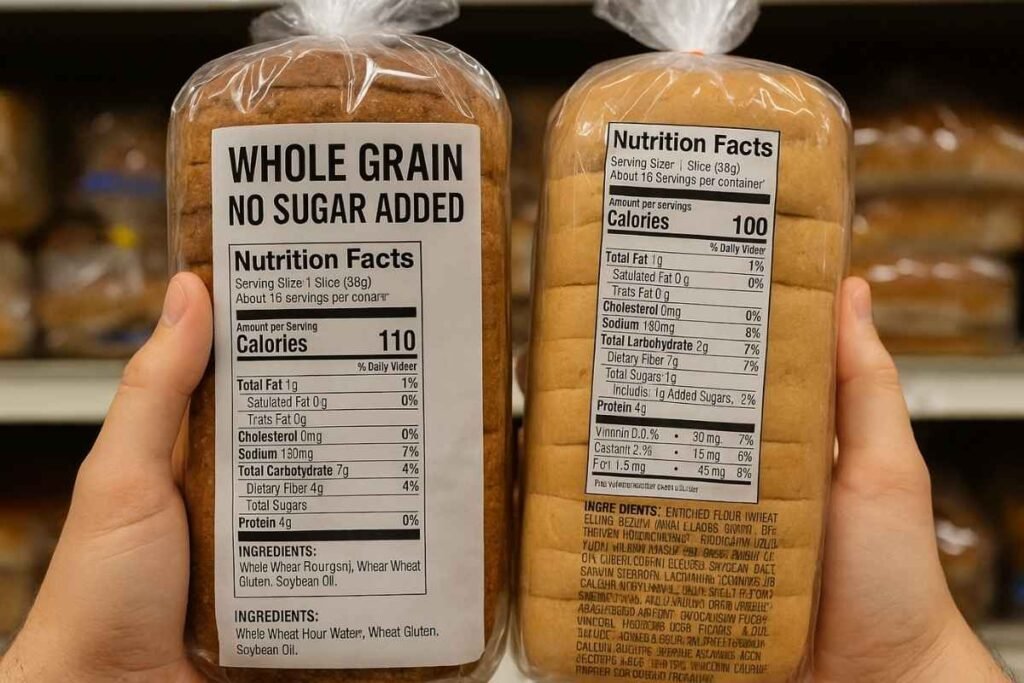
Finding healthy store bought bread can be tricky. Food labels are filled with marketing claims like multigrain, low fat or heart healthy, but those don’t always reflect true nutritional value. Here’s how to decode your choices:
- Read the ingredient list: Look for whole foods listed first. Avoid breads with high fructose corn syrup, hydrogenated oils or long chemical names.
- Check fiber content: Choose breads with at least 2–3 grams of fiber per slice.
- Watch the sodium and sugar: Opt for low sodium options with no added sugar.
- Look for fermentation or sprouted labels: These often indicate better nutrient absorption.
- Prefer organic ingredients: They often come without artificial preservatives or additives.
- Buy local or artisan bread: Artisan methods often use simpler ingredients and traditional baking techniques.
Making Your Own Healthy Bread
Homemade bread can be a rewarding way to control ingredients and support a healthy lifestyle. Use ancient grains, seeds and sprouted flour blends to craft your own nutrient dense loaf.
Try adding nutritional yeast for a savory, cheesy flavor without dairy. Choose low sodium, no sugar added recipes and explore baking methods like sourdough fermentation.
From quinoa bread to almond flour paleo loaves, homemade options support dietary preferences, whether vegan, keto or gluten free.
Conclusion
The healthiest bread isn’t one size fits all. It depends on your health goals, dietary restrictions and taste preferences. Whether you are choosing Ezekiel bread for its protein content, sourdough for gut health, or oat bread for heart health, the key is to prioritize whole ingredients, fiber and minimal processing.
By learning to read food labels, understanding bread types and even experimenting with baking your own, you’ll make smarter, tastier choices that align with your long term health and wellness.
FAQs
What is the #1 healthy bread?
While it depends on your goals, many nutritionists consider Ezekiel bread the top choice due to its sprouted grains, high protein and fiber rich content. It is minimally processed and nutrient dense.
Which type of bread is healthiest?
Whole grain breads with no added sugars or preservatives are often the healthiest. Look for varieties made with whole wheat, oats, flaxseed or sprouted grains.
What is healthy store bought bread?
Look for store bought bread that’s labeled 100% whole grain, has at least 3g of fiber per slice and doesn’t contain artificial preservatives or high sugar content. Brands offering authentic sourdough or Ezekiel style loaves are usually better choices.
What is the best bread to lower cholesterol?
Oat bread and flaxseed bread are excellent for lowering cholesterol due to their soluble fiber and omega 3 content. These support heart health naturally.
Is sourdough the healthiest bread?
Authentic sourdough is highly digestible and has a low glycemic index, making it a great option. It also supports gut microbiome diversity through natural fermentation.
What is the healthiest bread for weight loss?
Choose breads that are low in calories but high in fiber and protein, like flaxseed, sprouted grain or almond flour based keto breads. These support satiety and help regulate appetite.

